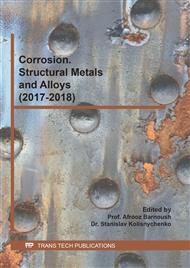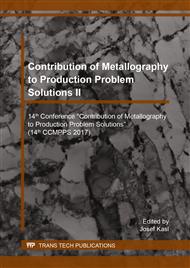p.142
p.149
p.156
p.162
p.168
p.174
p.183
p.189
p.197
Combining 3D Scanning with Standard Microscopy Methods for Assessment of Pitting Corrosion in Turbine Blades
Abstract:
Pitting corrosion is a known process in metals. Pitting, observed in turbine blades, is caused by corrosion mechanisms in operation environment that may contain aggressive chemical compounds. Environment, material composition and operating conditions determine the corrosion process causing a cavity formation and their critical growth. Crack initiation can be a following mechanism. Thus the critical cavity size is the important parameter and its precise estimation can avoid a turbine blade failure. Cavity shape as well as corrosion products inside cavities should be taken into account. 3D scanning technique performed during turbine shutdowns is shown to be a suitable method for measurement of critical cavity size. In this study, the accuracy of 3D technique was confirmed by standard sample preparation methods followed by microscopy focused on corrosion products observation. Cross-sectioning of blades was performed close to the cavities, sections were grinded to show the maximum cavity dimensions and finally polished. Cavity size was measured in few steps by Light Optical Microscopy during grinding to find the maximum dimensions and compare to 3D measurements. Local corrosion in cavities was evaluated by Scanning Electron Microscopy using Backscattered Electrons and Energy Dispersive X-ray Spectroscopy. Non-uniform Fe, Cr, Si rich oxides with dimensions from tens up to hundreds of micrometres were analysed in cavities. No significant effect on oxide removing was observed after using sandblasting technology except possible effect in larger pits. Cracks and pores were detected close to the vicinity of trailing edge of blade.
Info:
Periodical:
Pages:
168-173
Citation:
Online since:
November 2017
Keywords:
Price:
Сopyright:
© 2017 Trans Tech Publications Ltd. All Rights Reserved
Share:
Citation:



